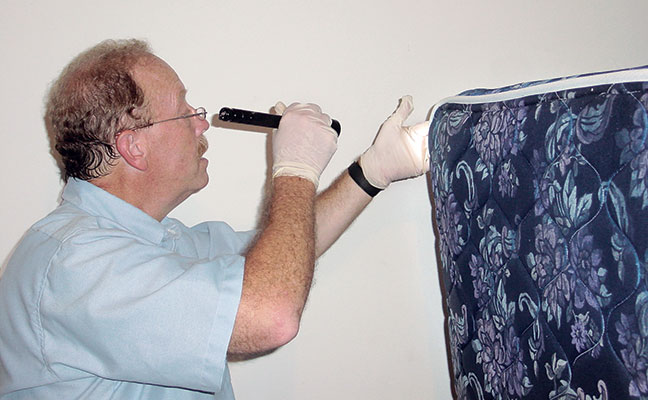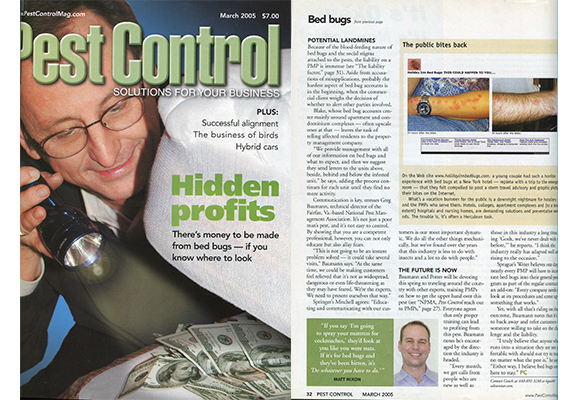
Gary Grossman, a district manager for Rose Pest Solutions, inspects a mattress for bed bugs.
Photo: Mark Sheperdigian, BCE
In the March 2005 issue, our cover story was titled “Hidden profits: There’s money to be made from bed bugs — if you know where to look.” What sounds like a no-brainer in 2018 was a rather radical concept 13 years ago. Bed bugs were just starting their comeback, after several decades of near-eradication.
But one factor that still keeps some pest management professionals (PMPs) holding bed bug service at arm’s length today was brought up in this article, which was written by PMP Hall of Famer Dr. Michael Potter, University of Kentucky: “In 1939, if bed bugs bit you, you didn’t sue anybody. There is a sense of absolute zero tolerance of bed bugs today.”
Our coverage in then-Pest Control magazine (which changed to its current name two years later) included an Orkin Pest Control survey that found bed bug infestations increased “300 percent between 2000 and 2001, 70 percent between 2001 and 2002, and 70 percent 2002 and 2003. The company said it had reports of infestations in 33 states in 2004.” These days, of course, Cimex lectularius can be found in all 50 states.
We also interviewed Andy Linares, president of New York City-based Bug Off Pest Control, about PMP “weak spots” from his point of view as a distributor. His list seems quaint today — except, perhaps, for No. 2:
1. They don’t know how to do the job right. “They’re doing it by the seat of their pants,” he reported in 2005. (Elsewhere in our coverage that issue, we listed five daylong training programs coming up coast to coast, jointly produced by the National Pest Management Association and our magazine, so that was about to change, at least). “Do the research, get the training and do it properly, which means inspecting thoroughly and methodically and allotting enough time to get the job done.”
2. They’re not charging properly. “This is a time-consuming job that requires a lot of labor, patience and material,” Linares said. “Don’t go the cheap route.”
3. They’re not taking advantage of follow-up business. “I recommend to my clients they build in an ongoing maintenance program, for which they can charge a fair price and assure a year-round schedule of applications.”

PUBLIC PERCEPTION
Our coverage in that issue included a short article titled “The public bites back,” which detailed how a young couple who stayed at an infested property in New York launched a website with the URL of HolidayInnBedBugs.com.
While thankfully, the site is no longer in existence, it and others like it at the time served as a reminder that the public’s fledgling interest in sharing information on the internet made treating for bed bugs all the more complex.
In some ways, this problem continues today — all it takes is for one Yelp reviewer to mention “bed bug” in a writeup, and a hotel’s reputation is sunk. That’s an opportunity if you’re working to get that property’s account — and a nightmare if it’s your existing account. And the name-shaming for hotels and apartments continues today with the likes of BedBugRegistry.com and BedBugReports.com, both of which were founded in 2006.
While bed bugs were on our magazine’s radar since its founding in 1933 as Exterminators Log, this 2005 cover story marked a turning point for our coverage. We realized it was a formidable market segment — one that should be talked about in nearly every issue.
Read more: Exploring bed bug opportunities
Leave A Comment